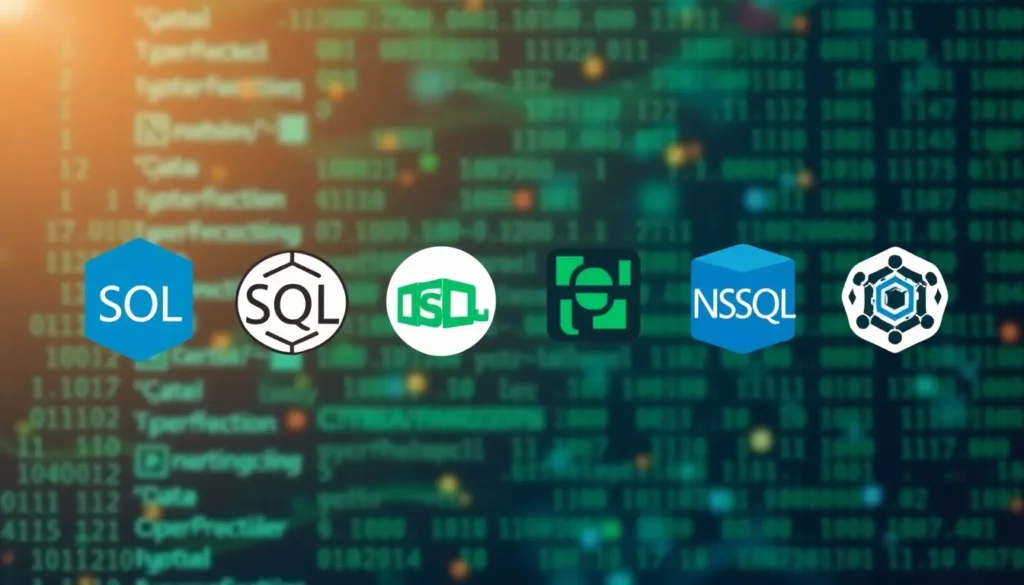In a world overflowing with data, the right database programming language can feel like finding a needle in a haystack—or maybe a unicorn in a data center. Whether it’s organizing mountains of information or optimizing performance, these languages are the unsung heroes of the tech realm. They’re like the secret sauce that makes your favorite dish irresistible, but with a side of logic and structure.
Imagine trying to communicate with a database using nothing but charades. Not pretty, right? That’s where database programming languages swoop in to save the day, allowing developers to efficiently manage and manipulate data like pros. From SQL to NoSQL, each language has its quirks and charms, making the journey through the database landscape both exciting and essential. Buckle up as we dive into the fascinating world of database programming languages and discover why they’re crucial for anyone navigating the digital age.
Overview of Database Programming Languages
Database programming languages manage and manipulate data stored in database management systems. They streamline interactions between developers and databases, ensuring efficient information organization. SQL emerges as the most prominent database language, widely used for structured data. It allows users to execute queries, update records, and manage database schemas effortlessly.
NoSQL languages cater to unstructured or semi-structured data. With flexibility and scalability, they provide alternative models for data storage and retrieval. Document-based NoSQL databases, such as MongoDB, enable users to store data in JSON-like formats, enhancing ease of use. Key-Value stores, including Redis, focus on simplicity and performance for specific use cases.
Procedural languages, like PL/SQL, enhance SQL’s capabilities by incorporating programming constructs such as loops and conditionals. They allow more complex data manipulation and automation. Additionally, declarative languages emphasize what needs to be done rather than how to do it, simplifying database interactions.
Embedded SQL integrates SQL within programming languages. This approach facilitates the development of applications that require database functionalities. Popular programming languages, such as Python and Java, offer libraries that enhance SQL capabilities, improving workflow and efficiency.
Understanding these diverse database programming languages equips developers to choose the right tools for their projects. Selecting the appropriate language based on data requirements, performance needs, and project goals can lead to optimized applications and successful outcomes. Each language serves a specific purpose in the evolving digital landscape, reflecting the growing importance of data management in today’s technology-driven environment.
Types of Database Programming Languages

Database programming languages can be categorized into several types, each serving distinct functions. Understanding these variations helps developers choose the most suitable language for their needs.
Procedural Languages
Procedural languages extend SQL’s functionality by incorporating programming constructs. PL/SQL, for example, allows developers to use loops, conditions, and variables. These features enable complex data manipulation tasks that structured queries alone cannot handle. Developers appreciate these languages for their ability to create stored procedures and functions, enhancing efficiency. Such capabilities streamline repetitive actions within databases, ultimately optimizing performance.
Declarative Languages
Declarative languages focus on what to do rather than how to do it. SQL exemplifies this by allowing users to specify queries without detailing execution steps. Simplicity in syntax makes these languages accessible for developers. Moreover, they promote clarity by emphasizing the desired outcome over procedural details. The ease of use creates a direct communication line with databases, requiring less code to achieve results. This approach ultimately enhances productivity when managing data.
Popular Database Programming Languages
Database programming languages play a crucial role in data management. Several prominent types exist, each with its unique features and applications.
SQL
SQL, or Structured Query Language, remains the standard for managing structured data. It allows users to perform tasks like querying, updating records, and managing database schemas. Many organizations leverage SQL databases, such as MySQL and PostgreSQL, for their reliability and robust performance. Developers utilize SQL’s simple syntax to write clear and efficient queries, which enhances productivity. Additionally, advanced SQL features, like window functions and Common Table Expressions (CTEs), enable sophisticated data analysis. Structured data’s organized nature makes SQL the go-to choice for most relational database management systems.
NoSQL
NoSQL languages cater primarily to unstructured and semi-structured data, focusing on flexibility and scalability. Examples like MongoDB and Redis provide different data models, such as document-based and key-value pairs. Developers appreciate NoSQL for handling large datasets that require rapid access and adaptability. With the ability to store diverse data types without a rigid schema, NoSQL databases support various applications, including real-time analytics and big data processing. As businesses increasingly depend on unstructured data, NoSQL languages gain traction, fulfilling the demand for dynamic data solutions.
PL/SQL
PL/SQL, or Procedural Language/SQL, enhances SQL’s capabilities by adding programming constructs. Features like loops, conditions, and variables empower developers to create complex data manipulation scripts. Built for Oracle databases, PL/SQL enables efficient storage and execution of procedures and functions. Developers benefit from its ability to handle large volumes of data with improved performance. This procedural extension to SQL simplifies interactions for sophisticated applications, making it invaluable in managing enterprise-level databases. Organizations choose PL/SQL for its robustness and integration with existing SQL standards.
Choosing the Right Database Programming Language
Choosing the appropriate database programming language requires careful consideration of various factors. Performance, scalability, and data structure needs often play crucial roles in decision-making.
Factors to Consider
Performance influences database language selection, particularly for data-heavy applications. Scalability becomes vital as businesses grow and data volumes increase. Compatibility with existing systems holds importance. Some languages seamlessly integrate with popular frameworks while others may require more effort. User expertise also matters. Developers familiar with SQL may favor it for relational databases. Meanwhile, novice users might find NoSQL easier to grasp for flexible schemas.
Use Cases
Different database programming languages serve specific scenarios. SQL shines in applications requiring structured data and complex transactions. Organizations often use it for traditional data processing tasks like inventory management and financial systems. NoSQL fits well in handling diverse data types, particularly in real-time analytics and IoT applications. Its flexibility supports use cases such as social media platforms and content management systems. Procedural languages enhance SQL capabilities for enterprise solutions needing complex data manipulations, including large-scale data warehousing.
Database programming languages are crucial for effective data management in today’s fast-paced digital landscape. They empower developers to interact seamlessly with databases while optimizing performance and ensuring data integrity. With SQL dominating structured data scenarios and NoSQL addressing the needs of unstructured data, each language offers unique advantages tailored to specific applications.
The choice of the right database programming language can significantly impact project success. By understanding the strengths of SQL, NoSQL, and procedural languages, developers can make informed decisions that align with their data requirements and business objectives. As technology continues to evolve, mastering these languages will remain essential for anyone looking to excel in the field of database management.






